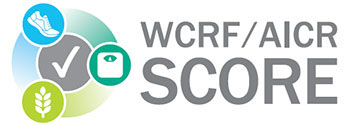
On this page...
- Key Points
- Definitions of Scoring Thresholds for Components of the 2018 WCRF/AICR Score
- Collecting Data to Calculate the Score
- Scoring by Component
Key Points
As described in the WCRF /AICR Third Expert Report![]() , there is strong evidence for causal links between lifestyle behaviors and cancer risk. The 2018 WCRF/AICR Score is a simple, standardized scoring system to quantify adherence to eight of the ten Cancer Prevention Recommendations from the Third Expert Report. The Score can be used to examine how adherence to these recommendations is associated with cancer-related outcomes.
, there is strong evidence for causal links between lifestyle behaviors and cancer risk. The 2018 WCRF/AICR Score is a simple, standardized scoring system to quantify adherence to eight of the ten Cancer Prevention Recommendations from the Third Expert Report. The Score can be used to examine how adherence to these recommendations is associated with cancer-related outcomes.
- The 2018 WCRF/AICR Score includes eight of the ten Cancer Prevention Recommendations, but the inclusion of the breastfeeding component is optional.
- All included recommendations are weighted equally (i.e., one is not given more weight over the others).
- Each recommendation is scored as 1, 0.5, or 0 points for meeting, partially meeting, and not meeting each recommendation, respectively. Depending on the exclusion or inclusion of the breastfeeding component, total Scores can range from 0 to 7 or 8 points, respectively.
- A higher Score reflects greater adherence to the recommendations.
- Within each recommendation, if more than one sub-recommendation is operationalized, the scoring weight is divided equally to retain a total of one point. That means that two sub-recommendations are worth up to 0.5 points each: 0.5, 0.25, or 0 points for meeting, partially meeting, and not meeting each sub-recommendation, respectively.
- The Score is applicable across populations and countries.
- It is important to note the Score is designed for population-based research, not as a direct tool for clinical or individual use.
Definitions of Scoring Thresholds for Components of the 2018 WCRF/AICR Score1
| 2018 WCRF/AICR Cancer Prevention Recommendations | Operationalization of Recommendations | Points |
|---|---|---|
| 1. Be a healthy weight | BMI (kg/m2): | |
| 18.5–24.9 | 0.5 | |
| 25–29.9 | 0.25 | |
| <18.5 or ≥30 | 0 | |
| Waist circumference (cm (in)): | ||
| Men: <94 (<37) Women: <80 (<31.5) |
0.5 | |
| Men: 94–<102 (37–<40) Women: 80–<88 (31.5–<35) |
0.25 | |
| Men: ≥102 (≥40) Women: ≥88 (≥35) |
0 | |
| 2. Be physically active | Total moderate-to-vigorous physical activity (min/wk): | |
| ≥150 | 1 | |
| 75–<150 | 0.5 | |
| <75 | 0 | |
| 3. Eat a diet rich in whole grains, vegetables, fruits, and beans | Fruits and vegetables (g/day): | |
| ≥400 | 0.5 | |
| 200–<400 | 0.25 | |
| <200 | 0 | |
| Total fiber (g/day): | ||
| ≥30 | 0.5 | |
| 15–<30 | 0.25 | |
| <15 | 0 | |
| 4. Limit consumption of “fast foods” and other processed foods high in fat, starches, or sugars | Percent of total kcal from ultra-processed foods (aUPFs): | |
| Tertile 1 | 1 | |
| Tertile 2 | 0.5 | |
| Tertile 3 | 0 | |
| 5. Limit consumption of red and processed meat | Total red meat (g/wk) and processed meat (g/wk): | |
| Red meat ≤500 (≤18 oz) and processed meat <21 (<0.75 oz) | 1 | |
| Red meat ≤500 (18 oz) and processed meat 21–<100 (0.75 oz–<3 oz) | 0.5 | |
| Red meat >500 or processed meat ≥100 (≥ 3 oz) | 0 | |
| 6. Limit consumption of sugar-sweetened drinks | Total sugar-sweetened drinks (g/day): | |
| 0 | 1 | |
| >0–≤250 (8.5 oz) | 0.5 | |
| >250 (8.5 oz) | 0 | |
| 7. Limit alcohol consumption7 | Total ethanol (g/day): | |
| 0 | 1 | |
| >0–≤28 (2 drinks) males and ≤14 (1 drink) females | 0.5 | |
| >28 (2 drinks) males and >14 (1 drink) females | 0 | |
| 8. (Optional) For mothers: breastfeed your baby, if you can | Exclusively breastfed over lifetime for a total of (mo): | |
| 6+ | 1 | |
| >0–<6 | 0.5 | |
| Never | 0 | |
| Total Score Range: 0–7 (or 0–8) | ||
Collecting Data to Calculate the Score
The 2018 WCRF/AICR Score is a metric that relies on previously collected data to calculate scores. It is not an assessment instrument that gathers data about weight, diet, physical activity, and breastfeeding. Data to calculate the Score can be collected from a variety of ways, including:
- Weight: Height and weight (to estimate BMI) and waist circumference via a self-report survey or measured by trained personnel
- Physical activity: Surveys with questions on moderate-to-vigorous physical activities; accelerometry
- Diet: Food frequency questionnaires; multiple 24-hour recalls
- Breastfeeding: Survey data
Scoring by Component
Details for the scoring by component are included below. Click on the icons in the graphic to jump to information about the component(s) of interest.
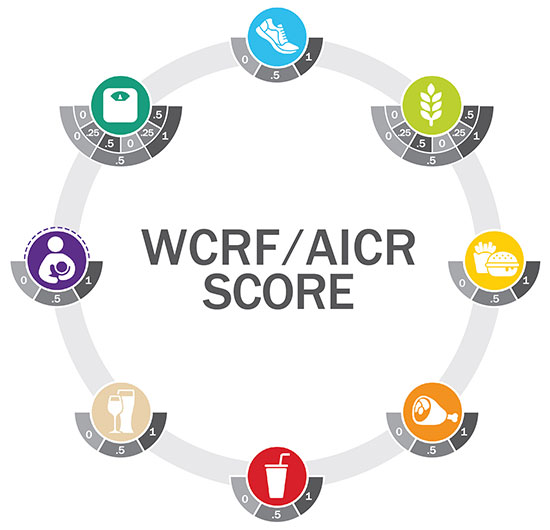
1. Weight component

This component operationalizes two goals from the 2018 WCRF/AICR Recommendation to “Be a healthy weight”: (1) keep weight as low as one can within the healthy range throughout life and (2) avoid weight gain through adulthood. The two sub-scores for this component are based on body mass index (BMI) and waist circumference (WC).
- BMI: BMI sub-score cut-points are based on the 2018 WCRF/AICR Recommendations, with further support from the World Health Organization
 and Centers for Disease Control and Prevention (CDC) guidance for those with underweight, normal weight, overweight, or obesity.
and Centers for Disease Control and Prevention (CDC) guidance for those with underweight, normal weight, overweight, or obesity. - WC: WC sub-score cut-points for meeting the recommendation are also based on the 2018 WCRF/AICR Recommendations, while the cut-points for partially and not meeting the recommendation are based on guidance from the CDC and National Heart, Lung, and Blood Institute. To be consistent with the guidance, WC cut-points are stratified by sex.
- Point range: BMI and WC each receive up to half a point: 0.5, 0.25, or 0 points for meeting, partially meeting, and not meeting each sub-recommendation, respectively. However, if data are only available for either BMI or WC, the sub-score is doubled to retain the 0–1 point total range for the weight component.
The AICR website provides further details on the evidence behind the healthy weight recommendation![]() .
.
2. Physical activity component
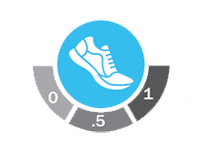
The 2018 WCRF/AICR Cancer Prevention Recommendation to “Be physically active” is operationalized to align with the goal to be at least moderately physically active and follow or exceed national guidelines.
- Moderate-to-vigorous physical activity (MVPA): In line with guidance from the World Health Organization (WHO) and the 2018 Physical Activity Guidelines for Americans, one point is given to those who complete ≥150 min of MVPA per week. The standard for the 0.5 cut-point is based on additional data from the 2018 Physical Activity Guidelines Advisory Committee Scientific Report, which shows a significantly decreased risk of all-cause mortality even for those who perform 75–<150 min of moderate physical activity per week. Moderate-to-vigorous physical activity below 75 min receives 0 points.
- Differences by country: The cut-points illustrated above are based on U.S. national guidelines and align with the WHO guidelines. However, other countries may have different guidelines. It is recommended that researchers adapt this physical activity component to align with the appropriate/relevant guidelines for the context of their study.
The AICR website provides further details on the evidence behind the physical activity recommendation![]() .
.
3. Whole grains, vegetables, fruits, and beans component

This component operationalizes two goals from the 2018 WCRF/AICR Recommendation to “Eat a diet rich in whole grains, vegetables, fruits, and beans.” Consistent with previous scores based on the 2007 WCRF/AICR Recommendations, the two sub-scores are based on fruits and vegetables and fiber intake: (1) Consume a diet that provides at least 30 g per day of fiber from food sources and (2) Eat a diet high in all types of plant foods including at least five portions or servings (at least 400 g or 15 oz in total) of a variety of non-starchy vegetables and fruits every day.
- Cut-points: The 2018 WCRF/AICR recommendations to consume at least 400 g of fruits and vegetables and 30 g per day of fiber from food sources were used to define the highest standard to meet the recommendation. Cut-points for partially (0.5 pt) and not meeting these recommendations (0 pt) were developed based on the consensus of the 2007 WCRF/AICR Recommendations-based scores, due to evidence supporting that meeting at least half of each recommendation is associated with health benefits.
- Point range: Fruits/vegetables and fiber each receive up to half a point: 0.5, 0.25, or 0 points for meeting, partially meeting, and not meeting recommendations, respectively. When summed, the component sub-score thus ranges from 0–1.
The AICR website provides further details on the evidence behind the whole grains, vegetables, fruits, and beans recommendation![]() .
.
4. Fast foods component
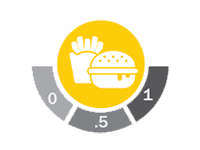
The specific recommendation to limit consumption of fast foods was a new component of the 2018 WCRF/AICR Cancer Prevention Recommendations; there was no standard way to categorize or define cut-points for fast foods based on the Third Expert Report or past research using the 2007 Recommendations. The corresponding 2007 recommendation was to limit energy-dense foods by consuming them sparingly, avoiding sugary drinks (now a separate recommendation), and consuming fast foods sparingly, if at all. Through an extensive literature search and consultation with the CUP Expert Panel, the definition of ultra-processed foods (UPFs) was adapted from the NOVA classification system![]() to create an adapted ultra-processed foods (aUPFs) variable.
to create an adapted ultra-processed foods (aUPFs) variable.
- Identifying aUPFs: The NOVA system classifies food products into one of four groups, depending on the amount of processing that food or food products undergo in preparation for consumption: 1) unprocessed or minimally processed foods; 2) processed culinary ingredients; 3) processed foods; or 4) UPF and drink products. The aUPF variable was created to remove UPF and drink products that are already addressed elsewhere in the Score (sugar-sweetened drinks and red and processed meat UPF items) and to match the definition from the 2018 WCRF/AICR Third Expert Report, which includes many prepared dishes, snacks, bakery foods and desserts, and confectionery (candy). Overall, we urge researchers to carefully study the NOVA classification system to apply an aUPF variable appropriate to their dietary instruments, the period of data collection, and their study populations.
- Authors are encouraged to clearly specify the categorization selected for any potentially ambiguous items.
- Dietary instrument variability: It is important to note that the inclusion of foods such as refined grains, yogurt, and milk alternatives in the aUPF variable is dependent on their dietary instrument and source. For example, if the dietary instrument used in a study stratifies plain yogurt from sweetened and flavored yogurts, the latter should be included in the aUPF variable. However, if this distinction is unavailable (all yogurts are addressed together), they should not be included to avoid penalizing participants who consume plain yogurt as part of their regular diet. This is particularly important in countries whose food systems primarily include plain yogurt. A similar approach should be taken with refined grains (e.g., white bread and pasta), milk products, and milk alternatives (e.g., soy and nut milk).
- Cut-points: Since there is no evidence in the current literature supporting standard cut-points for the NOVA classification system’s UPF variable, this is the only 2018 WCRF/AICR component with subjective cut-points based on tertiles within each specific dataset. This approach accounts for (1) the different UPFs in different countries’ food systems, (2) the variations in focus on UPF food sources in dietary questionnaires (e.g., not unfairly penalizing participants who complete a food frequency questionnaire (FFQ) containing more questions on UPFs than another FFQ), (3) the use of a FFQ versus a 24-hour recall, and (4) the different approaches researchers may take to quantify UPFs (e.g., percent of totalenergy versus percent of total grams).
The AICR website provides further details on the evidence as it relates to energy balance and body fatness![]() and evidence related to food preservation and processing
and evidence related to food preservation and processing![]() .
.
5. Red and processed meat component
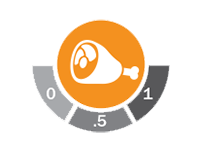
The goal operationalized from the 2018 WCRF/AICR Cancer Prevention Recommendation to “Limit consumption of red and processed meat” for those who consume red and/or processed meat is to consume no more than moderate amounts of red meat (≤350–500 g/week) and “very little, if any” processed meat. The latter is defined as <21 g/week (i.e., <3 g/day) to account for the very occasional processed meat consumer and/or recipes that may include minimally processed meat. Thus, we defined fully meeting the recommendation as consuming both <500 g red meat and <21 g processed meat per week; partially meeting the recommendation as consuming either <500 g red meat and 21–<100 g processed meat per week; and not meeting the recommendation as consuming either >500 g red meat or ≥100 g processed meat per week.
The AICR website provides further details on the evidence behind the red and processed meat recommendation![]() and evidence related to food preservation and processing
and evidence related to food preservation and processing![]() .
.
6. Sugar-sweetened drinks component
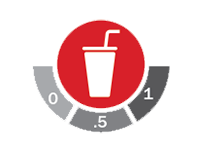
The goal for the 2018 WCRF/AICR Recommendation to “Limit consumption of sugar-sweetened drinks” “Do not consume sugar-sweetened drinks.” Sugar-sweetened drinks are defined as any liquids sweetened by adding free sugars and sugars “present in honey, syrups, fruit juices, and fruit juice concentrate” and therefore includes but is not limited to sodas, sports drinks, energy drinks, fruit juices with added sugars, and sweetened water, coffee, and tea beverages.
- Cut-points: The 2018 WCRF/AICR Score is consistent with most previous scores based on the 2007 WCRF/AICR Recommendations, whereby no consumption of sugar-sweetened drinks meets the recommendation; ≤250 g/day (1 drink) partially meets the recommendation; and >250 g/day does not meet the recommendation.
- Defining a non-drinker: The definition of “zero” sugar-sweetened drinks or a “non-drinker” varies across studies. The recommendation based on the cancer as well as obesity literature is to define a participant who consumes up to 250 g/month (8.5 oz or about one serving/month) as a non-drinker; consuming more falls within the 0.5 and 0 cut-point categories, depending on the amount of sugar-sweetened drinks consumed.
The AICR website provides further details on the evidence behind the sugar-sweetened beverages recommendation as it relates to energy balance and body fatness![]() and evidence related to non-alcoholic drinks
and evidence related to non-alcoholic drinks![]() .
.
7. Alcohol component
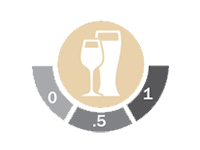
The strong evidence that any amount of regular alcohol consumption increases risk for some cancers supported a strengthening of the corresponding goal in the 2018 WCRF/AICR Recommendation. While the recommendation was similar in 2007 and 2018, to “Limit alcoholic drinks” and “limit alcohol consumption” respectively, the goal in the 2018 recommendations is “for cancer prevention, it’s best not to drink alcohol.” Therefore, fully meeting this recommendation requires zero alcohol consumption. However, if alcohol is consumed, the 2018 WCRF/AICR Recommendation supports following national guidelines. Thus, in the U.S., males and females who consume no more than 28 g of ethanol (2 drinks) and 14 g of ethanol (1 drink) per day, respectively, partially meet the recommendation; any consumption above this level does not meet the recommendation.
- Differences by country: Similar to physical activity, given that part of the alcohol sub-score is based on national guidelines, our paper focused on U.S. national guidelines. However, what constitutes a drink (alcohol content, serving size) and the sex-specific cut-points may vary by country; researchers should account for these differences when utilizing the Score.
- Defining a non-drinker: There is not a standard definition of “zero” alcohol intake or a “non-drinker” across studies. Given the limited evidence comparing non-drinkers to very rare drinkers, participants who consume up to 1 drink/month can be defined in this scoring approach as a non-drinker; consuming more than one drink/month falls within the 0.5 and 0 cut-point categories, depending on the amount consumed.
The AICR website provides further details on the evidence behind the alcohol recommendation![]() .
.
8. Breastfeeding component
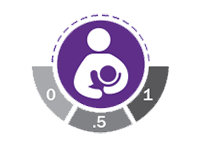
The 2018 WCRF/AICR Recommendation is “For mothers: breastfeed your baby, if you can.” This recommendation aligns with the guidance from the WHO![]() , which recommends that infants be exclusively breastfed until they are six months of age, and then for up to two years of age or beyond along with appropriate complementary foods.
, which recommends that infants be exclusively breastfed until they are six months of age, and then for up to two years of age or beyond along with appropriate complementary foods.
- Optional Score component: It is important to note that the inclusion of the breastfeeding component is not a mandatory component of the 2018 WCRF/AICR Score, as it only applies to a specific subpopulation. Its inclusion should be based on the research question and target population and is up to the discretion of the researcher.
- Cut-points: Cumulative breastfeeding for six or more months meets the recommendation, while any breastfeeding under six months and no breastfeeding partially meets and does not meet the recommendation, respectively.
The AICR website provides further details on the evidence behind the breastfeeding recommendation![]() .
.